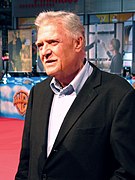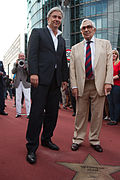Cinema of Germany
| Cinema of Germany | |
|---|---|
 The Berlin Wintergarten theatre was the site of the first cinema ever, with a short movie presented by the Skladanowsky brothers on 1 November 1895 | |
| No. of screens | 4,637 (2014)[1] |
| • Per capita | 6.2 per 100,000 (2011)[2] |
| Main distributors | Warner 19.5% Walt Disney 11.5% Sony Pictures 11.1%[3] |
| Produced feature films (2011)[4] | |
| Fictional | 128 (60.4%) |
| Animated | 5 (2.4%) |
| Documentary | 79 (37.3%) |
| Number of admissions (2014)[1] | |
| Total | 121,740,690 |
| • Per capita | 1.50 (2014) |
| National films | 32,100,000 (26,7%) |
| Gross box office (2014)[1] | |
| Total | €980 million |
The Cinema of Germany refers to the film industry based in Germany and can be traced back to the late 19th century. German cinema has made major technical and artistic contributions to film during the period from 1918-1933.
Germany witnessed major changes to its identity during the 20th and 21st century. Those changes determined the periodisation of national cinema into a succession of distinct eras and movements.[5]
1895–1918 German Empire
The history of cinema in Germany can be traced back to the years shortly after the medium's birth. On November 1, 1895 Max Skladanowsky and his brother Emil demonstrated their self-invented film projector the Bioscop at the Wintergarten music hall in Berlin. A 15-minute series of eight short films, it was the first screening of films to a paying audience in Europe.[6] This performance pre-dated the first paying public display of the Lumière brothers' Cinematographe in Paris on December 28 of the same year, a performance that Max Skladanowsky attended and at which he was able to ascertain that the Cinematographe was technically superior to his Bioscop. Other German film pioneers included the Berliners Oskar Messter and Max Gliewe, two of several individuals who independently in 1896 first used a Geneva drive (which allows the film to be advanced intermittently one frame at a time) in a projector, and the cinematographer Guido Seeber.
In its earliest days, the cinematograph was perceived as an attraction for upper class audiences, but the novelty of moving pictures did not last long. Soon, trivial short films were being shown as fairground attractions aimed at the working class and lower-middle class. The booths in which these films were shown were known in Germany somewhat disparagingly as Kintopps. Film-makers with an artistic bent attempted to counter this view of cinema with longer movies based on literary models, and the first German "artistic" films began to be produced from around 1910, an example being the Edgar Allan Poe adaptation The Student of Prague (1913) which was co-directed by Paul Wegener and Stellan Rye, photographed by Guido Seeber and starring actors from Max Reinhardt's company.
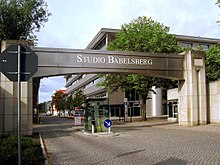
Early film theorists in Germany began to write about the significance of Schaulust, or "visual pleasure", for the audience, including the Dada movement writer Walter Serner: "If one looks to where cinema receives its ultimate power, into these strangely flickering eyes that point far back into human history, suddenly it stands there in all its massiveness: visual pleasure."[7] Visually striking sets and makeup were key to the style of the expressionist films that were produced shortly after World War I.
Cinemas themselves began to be established landmarks in the years immediately before World War I. Before this, German filmmakers would tour with their works, travelling from fairground to fairground. The earliest ongoing cinemas were set up in cafes and pubs by owners who saw a way of attracting more customers. The storefront cinema was called a Kientopp, and this is where films were viewed for the most part before World War I.[8] The first standalone, dedicated cinema in Germany was opened in Mannheim in 1906, and by 1910, there were over 1000 cinemas operating in Germany.[8] Henny Porten and Asta Nielsen (the latter originally from Denmark) were the first major film stars in Germany.[9]
Prior to 1914, however, many foreign films were imported. In the era of the silent film there were no language boundaries and Danish and Italian films were particularly popular in Germany. The public's desire to see more films with particular actors led to the development in Germany, as elsewhere, of the phenomenon of the film star; the actress Henny Porten was one of the earliest German stars. Public desire to see popular film stories being continued encouraged the production of film serials, especially in the genre of mystery films, which is where the director Fritz Lang began his illustrious career.
The outbreak of World War I and the subsequent boycott of, for example, French films left a noticeable gap in the market. By 1916, there already existed some 2000 fixed venues for movie performances and initially film screenings were supplemented or even replaced by variety turns. In 1917 a process of concentration and partial nationalisation of the German film industry began with the founding of Universum Film AG (UFA), which was partly a reaction to the very effective use that the Allied Powers had found for the new medium for the purpose of propaganda. Under the aegis of the military, so-called Vaterland films were produced, which equalled the Allies' films in the matter of propaganda and disparagement of the enemy. Audiences however did not care to swallow the patriotic medicine without the accompanying sugar of the light-entertainment films which, consequently, Ufa also promoted. The German film industry soon became the largest in Europe.
1918–1933 Weimar Republic
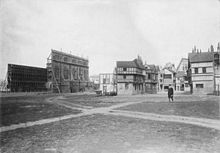
Three inventors came up with the Tri-Ergon sound-on-film system in 1918. From 1922 to 1926, they tried to introduce the process to film production, and UFA showed an interest, but, possibly due to financial difficulties, never made a sound film.[10] In the period immediately following World War I, the film industry boomed, helped by the 1920s German inflation. This enabled film makers to borrow money in Papiermark which would be vastly devalued by the time it had to be repaid. Nevertheless, film budgets were tight and the need to save money was a contributing factor to the rise of German Expressionism, as was the desire to move forward and embrace the future that swept most of Europe at the time. Expressionist movies relied heavily on symbolism and artistic imagery rather than stark realism to tell their stories. Given the grim mood in post-WWI Germany, it was not surprising that these films focused heavily on crime and horror. The film usually credited with sparking the popularity of expressionism is Robert Wiene's The Cabinet of Dr. Caligari (1920). It painted a picture on the cinema screen with non-realistic sets built with exaggerated geometry, images painted on the floors and walls to represent objects (and often light and shadow), and a story involving the dark hallucinations of who may be an insane man. An exaggerated acting style and unnatural costume design are other trademarks of this movement. Other notable works of Expressionism are Friedrich Wilhelm Murnau's Nosferatu (1922), and Carl Boese and Paul Wegener's The Golem: How He Came Into the World (1920). The Expressionist movement began to wane during the mid-1920s, but it continued to influence world cinema for years afterward. Its influence is particularly noticeable in American horror films and film noir, and the works of European directors as diverse as Jean Cocteau and Ingmar Bergman.

UFA had been privatised in 1921 by a sale of the state's holdings to the Deutsche Bank and had become the mainstay of an industry that produced up to 600 feature films a year in the 1920s. In addition to UFA, there were some 230 film companies in business in Berlin alone at this time. However, film industry financing was a fragile business in the unstable economy of the Weimar Republic, and this, coupled with the industry's tendency to overreach itself financially (such as in the production of Fritz Lang's Metropolis (1927), perhaps the most famous German film of this period), frequently led to bankruptcies and financial ruin. UFA itself was forced to go into a disadvantageous partnership called Parufamet with the American studios Paramount and MGM in 1925 before being taken over by the nationalist industrialist and newspaper owner Alfred Hugenberg in 1927. The company's financial travails did not prevent it from producing numerous significant films throughout this period, among them, Ernst Lubitsch's Madame Du Barry (1919), Lang's epic production of Die Nibelungen, and Murnau's The Last Laugh (1925), and the development of the studios at Babelsberg, originally established in 1912 but later taken over by UFA and expanded massively to accommodate the filming of Metropolis, gave the German film industry a highly developed infrastructure. Babelsberg was at the centre of German filmmaking for several years, "the German equivalent to Hollywood".[11]
In addition to developments in the industry itself, the Weimar period saw the birth of film criticism as a serious discipline whose practitioners included Rudolf Arnheim in Die Weltbühne and in Film als Kunst (1932), Béla Balázs in Der Sichtbare Mensch (1924), Siegfried Kracauer in the Frankfurter Zeitung, and Lotte H. Eisner in the Filmkurier.
After the influence of Expressionism began to wane a variety of other genres and styles developed in the 1920s. Movies influenced by New Objectivity with socially concerned themes and a return to realism, among them films by Georg Wilhelm Pabst such as Joyless Street (Die Freudlose Gasse) (1925), Pandora's Box (1929), and The Loves of Jeanne Ney became widespread in the later 1920s. The movement is best characterized by tendency to understand reality and characters in terms of inanimate objects and personal possessions. Often associated with "street films." The influence of New Objectivity may also be seen in the trend towards so-called "asphalt" and "morality" films which dealt with scandalous subjects like abortion, prostitution, homosexuality, oral sex and addiction. In contrast, the genre of the Bergfilm was developedin the same period, mainly by the director Arnold Fanck, in which individuals were shown battling against nature in the mountains. Animators and directors of experimental film such as Lotte Reiniger, Oskar Fischinger and Walter Ruttmann were also very active in Germany in the 1920s. Ruttman's experimental documentary Berlin: Die Sinfonie der Großstadt (1927) epitomises the energy of 1920s Berlin. The polarised politics of the Weimar period were also reflected in some its movies. A series of patriotic films on Prussian history starring Otto Gebühr as Frederick the Great were produced throughout the 1920s and were popular with the nationalist right-wing, who strongly criticised the "asphalt" films' decadence.
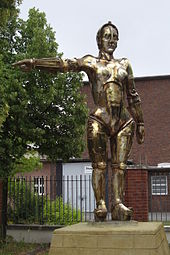
Many of the films during that came out of Germany at this time were historical spectacles designed to pull in a large crowd and international release all while adhering to a smaller budget. Ernst Lubitsch's Madame DuBarry explored the French revolution through window of the intimate life of King Louis' mistress. Many of his films tended to how the intimate and petty passions of the rich and powerful are ironically responsible for huge historical events in the public realm.
The fourth key artistic movement of German cinema at this time was that of Kammerspiel or "chamber drama." Associated in particular with the screenwriter Carl Meyer and films such as Murnau's Last Laugh, this movement was in many ways a reaction against spectacle and expressionism. These films tended to revolve around ordinary people living in often dreary, ordinary settings. Often called "instinct" films because they emphasized the impulses and intimate psychology of the characters. The number of sets was often kept to a small number as well. This movement also relied heavily on the use of camera movements to explore the rather intimate and simple spaces.
The arrival of sound at the very end of the 1920s produced a final artistic flourish of German film before the collapse of the Weimar Republic in 1933. Sound production and distribution were quickly taken up by the German film industry and by 1932 Germany had 3,800 cinemas equipped to play sound films. Der blaue Engel (1930) by the Austrian director Josef von Sternberg was Germany's first talkie (shot simultaneously in German and English) and made an international star of Marlene Dietrich. Other early sound films of note include Berlin Alexanderplatz, Pabst's Bertolt Brecht adaptation The Threepenny Opera and Lang's M (all 1931) as well as Hochbaum's Razzia in Sankt Pauli & produced by Justin Rosenfeld (1932). Brecht was also one of the creators of the explicitly communist film Kuhle Wampe (1932), which was banned soon after its release. Aside from the major movements already addressed, German filmmakers at this time were known as innovators for their creative usage of mise-en-scene and camera movement.
1933–1945 Nazi Germany
The uncertain economic and political situation in Weimar Germany had already led to a number of film-makers and performers leaving the country, primarily for the United States; Ernst Lubitsch moved to Hollywood as early as 1923, the Hungarian-born Michael Curtiz in 1926. Some 1,500 directors, producers, actors and other film professionals emigrated in the years after the Nazis came to power. Among them were such key figures as the producer Erich Pommer, the studio head of Ufa, stars Marlene Dietrich and Peter Lorre, and director Fritz Lang. Lang's exodus to America is legendary; it is said that Metropolis so greatly impressed Joseph Goebbels that he asked Lang to become the head of his propaganda film unit. Lang fled to America instead, where he had a long and prosperous career. Many up-and-coming German directors also fled to the U.S., having a major influence on American film as a result. A number of the Universal Horror films of the 1930s were directed by German emigrees, including Karl Freund, Joe May and Robert Siodmak. Directors Edgar Ulmer and Douglas Sirk and the Austrian-born screenwriter (and later director) Billy Wilder also emigrated from Nazi Germany to Hollywood success. Not all those in the film industry threatened by the Nazi regime were able to escape; the actor and director Kurt Gerron, for example, perished in a concentration camp.
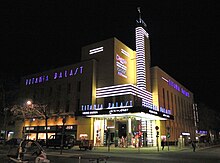
Within weeks of the Machtergreifung, Alfred Hugenberg had effectively turned over Ufa to the ends of the Nazis, excluding Jews from employment in the company in March 1933, several months before the foundation in June of the Reichsfilmkammer (Reich Chamber of Film), the body of the Nazi state charged with control of the film industry, which marked the official exclusion of Jews and foreigners from employment in the German film industry. As part of the process of Gleichschaltung all film production in Germany was subordinate to the Reichsfilmkammer, which was directly responsible to Goebbel's Propaganda ministry, and all those employed in the industry had to be members of the Reichsfachschaft Film. "Non-Aryan" film professionals and those whose politics or personal life were unacceptable to the Nazis were excluded from the Reichsfachschaft and thus denied employment in the industry. Some 3,000 individuals were affected by this employment ban. In addition, as journalists were also organised as a division of the Propaganda Ministry, Goebbels was able to abolish film criticism in 1936 and replace it with Filmbeobachtung (film observation); journalists could only report on the content of a film, not offer judgement on its artistic or other worth.
With the German film industry now effectively an arm of the totalitarian state, no films could be made that were not ostensibly in accord with the views of the ruling regime. However, despite the existence of anti-semitic propaganda works such as The Eternal Jew (1940)—which was a box-office flop—and the more sophisticated but equally anti-semitic Jud Süß (1940), which achieved commercial success at home and elsewhere in Europe, the majority of German films from the National Socialist period were intended principally as works of entertainment. The import of foreign films was legally restricted after 1936 and the German industry, which was effectively nationalised in 1937, had to make up for the missing foreign films (above all American productions). Entertainment also became increasingly important in the later years of World War II when the cinema provided a distraction from Allied bombing and a string of German defeats. In both 1943 and 1944 cinema admissions in Germany exceeded a billion,[13] and the biggest box office hits of the war years were Die große Liebe (1942) and Wunschkonzert (1941), which both combine elements of the musical, wartime romance and patriotic propaganda, Frauen sind doch bessere Diplomaten (1941), a comic musical which was one of the earliest German films in colour, and Vienna Blood (1942), the adaptation of a Johann Strauß comic operetta. The importance of the cinema as a tool of the state, both for its propaganda value and its ability to keep the populace entertained, can be seen in the filming history of Veit Harlan's Kolberg (1945), the most expensive film of the Nazi era, for the shooting of which tens of thousands of soldiers were diverted from their military positions to appear as extras.
Despite the emigration of many film-makers and the political restrictions, the period was not without technical and aesthetic innovations, the introduction of Agfacolor film production being a notable example. Technical and aesthetic achievement could also be turned to the specific ends of the Nazi state, most spectacularly in the work of Leni Riefenstahl. Riefenstahl's Triumph of the Will (1935), documenting the 1934 Nuremberg Rally, and Olympia (1938), documenting the 1936 Summer Olympics, pioneered techniques of camera movement and editing that have influenced many later films. Both films, particularly Triumph of the Will, remain highly controversial, as their aesthetic merit is inseparable from their propagandising of Nazi ideals.
1945–1989 East Germany
East German cinema initially profited from the fact that much of the country's film infrastructure, notably the former UFA studios, lay in the Soviet occupation zone which enabled film production to get off the ground more quickly than in the Western sectors. The authorities in the Soviet Zone were keen to re-establish the film industry in their sector and an order was issued to re-open cinemas in Berlin in May 1945 within three weeks of German capitulation. The film production company Deutsche Film-Aktiengesellschaft or DEFA was founded on May 17, 1946, and took control of the film production facilities in the Soviet Zone which had been confiscated by order of the Soviet Military Administration in Germany in October 1945. Theoretically a joint-stock company, the majority interest in DEFA was actually held by the Socialist Unity Party of Germany (SED) which became the ruling party of the German Democratic Republic (GDR) after 1949, formally placing DEFA as the state-owned monopoly for film production in East Germany. A sister "company", Progress Filmverleih, had also been established as a similar monopoly for domestic film distribution, its principal "competition" being Sovexportfilm, which handled distribution of Soviet films.

In total DEFA produced some 900 feature films during its existence as well as around 800 animated films and over 3000 documentaries and short films. In its early years, production was limited due to strict controls imposed by the authorities which restricted the subject-matter of films to topics that directly contributed to the Communist project of the state. Excluding newsreels and educational films, only 50 films were produced between 1948 and 1953. However, in later years numerous films were produced on a variety of themes. DEFA had particular strengths in children's films, notably fairy tale adaptations such as Drei Haselnüsse für Aschenbrödel (Three Nuts for Cinderella) (1973), but it also attempted other genre works: science-fiction, for example Der schweigende Stern (The Silent Star) (1960), an adaptation of a Stanislaw Lem novel, or "red westerns" such as The Sons of the Great Mother Bear (1966) in which, in contrast to the typical American western, the heroes tended to be Native Americans. Many of these genre films were co-productions with other Warsaw Pact countries.
Notable non-genre films produced by DEFA include Wolfgang Staudte's adaptation of Heinrich Mann's Der Untertan (1951); Konrad Wolf's Der geteilte Himmel (Divided Heaven) (1964), an adaptation of Christa Wolf's novel; Frank Beyer's adaptation of Jurek Becker's Jacob the Liar (1975), the only East German film to be nominated for an Oscar; The Legend Of Paul And Paula (1973), directed by Heiner Carow from Ulrich Plenzdorf's novel; and Solo Sunny (1980), again the work of Konrad Wolf.
However, film-making in the GDR was always constrained and oriented by the political situation in the country at any given time. Ernst Thälmann, the communist leader in the Weimar period, was the subject of several hagiographical films in the 1950s (Ernst Thälmann, 1954), and although East German filmmaking moved away from this overtly Stalinist approach in the 1960s, filmmakers were still subject to the changing political positions, and indeed the whims, of the SED leadership. For example, DEFA's full slate of contemporary films from 1966 were denied distribution, among them Frank Beyer's Traces of Stones (1966) which was pulled from distribution after three days, not because it was antipathetic to communist principles, but because it showed that such principles, which it fostered, were not put into practice at all times in East Germany. The huge box-office hit The Legend of Paul and Paula was initially threatened with a distribution ban because of its satirical elements and supposedly only allowed a release on the say-so of Party General Secretary Erich Honecker.
In the late 1970s numerous film-makers left the GDR for the West as a result of restrictions on their work, among them director Egon Günther and actors Angelica Domröse, Eva-Maria Hagen, Katharina Thalbach, Hilmar Thate, Manfred Krug and Armin Mueller-Stahl. Many had been signatories of a 1976 petition opposing the expatriation of socially critical singer-songwriter Wolf Biermann and had had their ability to work restricted as a result.
In the final years of the GDR, the availability of television and the programming and films on television broadcasts reaching into the GDR via the uncontrollable airwaves, DEFA's productions' importance was reduced, although its continuing role in producing shows for East German television channel remained. Following the Wende, DEFA had ceased production altogether, and its studios and equipment was sold off by the Treuhand in 1992, but its intellectual property rights were handed to the charitable DEFA-Stiftung (DEFA Foundation) which exploits these rights in conjunction with a series of private companies, especially the quickly privatized Progress Film GmbH, which has issued several East German films with English subtitles since the mid-1990s.
1945–1989 West Germany
1945–1960 Reconstruction
The occupation and reconstruction of Germany by the Four Powers in the period immediately after the end of World War II brought a major and long-lasting change to the economic conditions under which the industry in Germany had previously operated. The holdings of Ufa were confiscated by the Allies and, as part of the process of decartelisation, licences to produce films were shared between a range of much smaller companies. In addition, the Occupation Statute of 1949, which granted partial independence to the newly created Federal Republic of Germany, specifically forbade the imposition of import quotas to protect German film production from foreign competition, the result of lobbying by the American industry as represented by the MPAA.
Amidst the devastation of the Stunde Null year of 1945 cinema attendance was unsurprisingly down to a fraction of its wartime heights, but already by the end of the decade it had reached levels that exceeded the pre-war period.[13] For the first time in many years, German audiences had free access to cinema from around the world and in this period the films of Charlie Chaplin remained popular, as were melodramas from the United States. Nonetheless, the share of the film market for German films in this period and into the 1950s remained relatively large, taking up some 40 percent of the total market. American films took up around 30 percent of the market despite having around twice as many films in distribution as the German industry in the same time frame.[14]
Many of the German films of the immediate post-war period can be characterised as belonging to the genre of the Trümmerfilm (literally "rubble film"). These films show strong affinities with the work of Italian neorealists, not least Roberto Rossellini's neorealist trilogy which included Germany Year Zero (1948), and are concerned primarily with day-to-day life in the devastated Germany and an initial reaction to the events of the Nazi period (the full horror of which was first experienced by many in documentary footage from liberated concentration camps). Such films include Wolfgang Staudte's Die Mörder sind unter uns (The Murderers are among us) (1946), the first film made in post-war Germany (produced in the soviet sector), and Wolfgang Liebeneiner's Liebe 47 (Love 47) (1949), an adaptation of Wolfgang Borchert's play Draußen vor der Tür.
Despite the advent of a regular television service in the Federal Republic in 1952, cinema attendances continued to grow through much of the 1950s, reaching a peak of 817.5 million visits in 1956.[13] The majority of the films of this period set out to do no more than entertain the audience and had few pretensions to artistry or active engagement with social issues. The defining genre of the period was arguably the Heimatfilm ("homeland film"), in which morally simplistic tales of love and family were played out in a rural setting, often in the mountains of Bavaria, Austria or Switzerland. In their day Heimatfilms were of little interest to more scholarly film critics, but in recent years they have been the subject of study in relation to what they say about the culture of West Germany in the years of the Wirtschaftswunder. Other film genres typical of this period were adaptations of operettas, hospital melodramas, comedies and musicals. Many films were remakes of earlier Ufa productions.
Rearmament and the founding of the Bundeswehr in 1955 brought with it a wave of war films which tended to depict the ordinary German soldiers of World War II as brave and apolitical.[15] The Israeli historian Omer Bartov wrote that German films of the 1950s showed the average German soldier as a heroic victim: noble, tough, brave, honourable, and patriotic while fighting hard in a senseless war for a regime that he did not care for.[16] The 08/15 film trilogy of 1954–55 concerns a sensitive young German soldier who would rather play the piano than fight, and who fights on the Eastern Front without understanding why; however, no mention is made of the genocidal aspects of Germany's war in East.[15] The last of the 08/15 films ends with Germany occupied by a gang of American soldiers portrayed as bubble-gum chewing, slack-jawed morons and uncultured louts, totally inferior in every respect to the heroic German soldiers shown in the 08/15 films.[15] The only exception is the Jewish American officer, who is shown as both hyper-intelligent and very unscrupulous, which Bartov noted seems to imply that the real tragedy of World War II was the Nazis did not get a chance to exterminate all of the Jews, who have now returned with Germany's defeat to once more exploit the German people.[15]
In The Doctor of Stalingrad (1958) dealing with German POWs in the Soviet Union, Germans are portrayed as more civilized, humane and intelligent than the Soviets, who are shown for the most part as Mongol savages who brutalized the German POWs.[17] One of the German POWs successfully seduces the beautiful and tough Red Army Captain Alexandra Kasalniskaya (Eva Bartok) who prefers him to the sadistic camp commandant, which as Bartov comments also is meant to show that even in defeat, German men were more sexually virile and potent than their Russian counterparts.[17] In Hunde, wolt ihr ewig leben? (Dogs, do you want to live forever?) of 1959, which deals with the Battle of Stalingrad, the focus is on celebrating the heroism of the German soldier in that battle, who are shown as valiantly holding out against overwhelming odds with no mention at all of what those soldiers were fighting for, namely National Socialist ideology or the Holocaust.[18] This period also saw a number of films that depicted the military resistance to Hitler. In Des Teufels General (The Devil's General) of 1954, a Luftwaffe general named Harras loosely modeled after Ernst Udet, appears at first to be cynical fool, but turns out to an anti-Nazi who is secretly sabotaging the German war effort by designing faulty planes.[19] Bartov commented that in this film, the German officer corps is shown as a group of fundamentally noble and civilized men who happened to be serving an evil regime made up of a small gang of gangsterish misfits totally unrepresentative of German society, which served to exculpate both the officer corps and by extension Germany society.[20] Bartov wrote that no German film of the 1950s showed the deep commitment felt by many German soldiers to National Socialism, the utter ruthless way the German Army fought the war and the mindless nihilist brutality of the later Wehrmacht.[21] Bartov wrote that German film-makers liked to show the heroic last stand of the 6th Army at Stalingrad, but none has so far showed the 6th Army's massive co-operation with the Einsatzgruppen in murdering Soviet Jews in 1941.[22]
Even though there are countless film adaptations of Edgar Wallace novels worldwide, the crime films produced by the German company Rialto Film between 1959 and 1972 are the best-known of those, to the extent that they form their own subgenre known as Krimis (abbreviation for the German term "Kriminalfilm" (or "Kriminalroman"). Other Edgar Wallace adaptations in a similar style were made by the Germans Artur Brauner and Kurt Ulrich, and the British producer Harry Alan Towers.
The international significance of the West German film industry of the 1950s could no longer measure up to that of France, Italy, or Japan. German films were only rarely distributed internationally as they were perceived as provincial. International co-productions of the kind which were becoming common in France and Italy tended to be rejected by German producers (Schneider 1990:43). However a few German films and film-makers did achieve international recognition at this time, among them Bernhard Wicki's Oscar-nominated Die Brücke (The Bridge) (1959), and the actresses Hildegard Knef and Romy Schneider.
1960–1970 Cinema in crisis
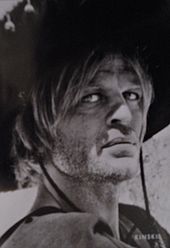
In the late 1950s, the growth in cinema attendance of the preceding decade first stagnated and then went into freefall throughout the 1960s. By 1969 West German cinema attendance at 172.2 million visits per year was less than a quarter of its 1956 post-war peak.[13] As a consequence of this, numerous German production and distribution companies went out of business in the 1950s and 1960s and cinemas across the Federal Republic closed their doors; the number of screens in West Germany almost halved between the beginning and the end of the decade.[citation needed]
Initially, the crisis was perceived as a problem of overproduction. Consequently, the German film industry cut back on production. 123 German movies were produced in 1955, only 65 in 1965. However, many German film companies followed the 1960s trends of international co-productions with Italy and Spain in such genres as spaghetti westerns and Eurospy films with films shot in those nations or in Yugoslavia that featured German actors in the casts.
The roots of the problem lay deeper in changing economic and social circumstances. Average incomes in the Federal Republic rose sharply and this opened up alternative leisure activities to compete with cinema-going. At this time too, television was developing into a mass medium that could compete with the cinema. In 1953 there were only 1,000,000 sets in West Germany; by 1962 there were 7 million (Connor 1990:49) (Hoffman 1990:69).
The majority of films produced in the Federal Republic in the 1960s were genre works: westerns, especially the series of movies adapted from Karl May's popular genre novels which starred Pierre Brice as the Apache Winnetou and Lex Barker as his white blood brother Old Shatterhand; thrillers and crime films, notably a series of Edgar Wallace movies from Rialto Film in which Klaus Kinski, Heinz Drache, Karin Dor and Joachim Fuchsberger were among the regular players. The traditional Krimi films expanded into series based on German pulp fiction heroes such as Jerry Cotton played by George Nader and Kommissar X played by Tony Kendall and Brad Harris. West Germany also made several horror films including ones starring Christopher Lee. The two genres were combined in the return of Doctor Mabuse in a series of several films of the early 1960s.
At the end of the 1960s softcore sex films, both the relatively serious Aufklärungsfilme (sex education films) of Oswalt Kolle and such exploitation films as Schulmädchen-Report (Schoolgirl Report) (1970) and its successors were produced into the 1970s. Such movies were commercially successful and often enjoyed international distribution, but won little acclaim from critics.
1960–1980 New German Cinema
In the 1960s more than three quarters of the regular cinema audience were lost as consequence of the rising popularity of TV sets at home. As a reaction to the artistic and economic stagnation of German cinema, a group of young film-makers issued the Oberhausen Manifesto on February 28, 1962. This call to arms, which included Alexander Kluge, Edgar Reitz, Peter Schamoni and Franz-Josef Spieker among its signatories, provocatively declared "Der alte Film ist tot. Wir glauben an den neuen" ("The old cinema is dead. We believe in the new cinema"). Other up-and-coming filmmakers allied themselves to this Oberhausen group, among them Rainer Werner Fassbinder, Volker Schlöndorff, Werner Herzog, Jean-Marie Straub, Wim Wenders, Werner Schroeter and Hans-Jürgen Syberberg in their rejection of the existing German film industry and their determination to build a new cinema founded on artistic and social measures rather than commercial success. Most of these directors organized themselves in, or partially co-operated with, the film production and distribution company Filmverlag der Autoren established in 1971, which throughout the 1970s brought forth a number of critically acclaimed films.
Despite the foundation of the Kuratorium Junger Deutscher Film (Young German Film Committee) in 1965, set up under the auspices of the Federal Ministry of the Interior to support new German films financially, the directors of this New German Cinema were consequently often dependent on money from television. Young filmmakers had the opportunity to test their mettle in such programmes as the stand-alone drama and documentary series Das kleine Fernsehspiel (The Little TV Play) or the television films of the crime series Tatort. However, the broadcasters sought TV premieres for the films which they had supported financially, with theatrical showings only occurring later. As a consequence, such films tended to be unsuccessful at the box office.
This situation changed after 1974 when the Film-Fernseh-Abkommen (Film and Television Accord) was agreed between the Federal Republic's main broadcasters, ARD and ZDF, and the German Federal Film Board (a government body created in 1968 to support film-making in Germany).[23] This accord, which has been repeatedly extended up to the present day, provides for the television companies to make available an annual sum to support the production of films which are suitable for both theatrical distribution and television presentation. (The amount of money provided by the public broadcasters has varied between 4.5 and 12.94 million euros per year. Under the terms of the accord, films produced using these funds can only be screened on television 24 months after their theatrical release. They may appear on video or DVD no sooner than six months after cinema release. Nevertheless the New German Cinema found it difficult to attract a large domestic or international audience.
The socially critical films of the New German Cinema strove to delineate themselves from what had gone before and the works of auteur film-makers such as Kluge and Fassbinder are examples of this, although Fassbinder in his use of stars from German cinema history also sought a reconciliation between the new cinema and the old. In addition, a distinction is sometimes drawn between the avantgarde "Young German Cinema" of the 1960s and the more accessible "New German Cinema" of the 1970s. For their influences the new generation of film-makers looked to Italian neorealism, the French Nouvelle Vague and the British New Wave but combined this eclectically with references to the well-established genres of Hollywood cinema. The New German Cinema dealt with contemporary German social problems in a direct way; the Nazi past, the plight of the Gastarbeiter ("guest workers"), and modern social developments, were all subjects prominent in New German Cinema films.[24]
Films such as Kluge's Abschied von Gestern (1966), Herzog's Aguirre, the Wrath of God (1972), Fassbinder's Fear Eats the Soul (1974) and The Marriage of Maria Braun (1979), and Wenders' Paris, Texas (1984) found critical approval. Often the work of these auteurs was first recognised abroad rather than in Germany itself. The work of post-war Germany's leading novelists Heinrich Böll and Günter Grass provided source material for the adaptations The Lost Honour of Katharina Blum (1975) (by Schlöndorff and Margarethe von Trotta) and The Tin Drum (1979) (by Schlöndorff alone) respectively, the latter becoming the first German film to win the Academy Award for Best Foreign Language Film. The New German Cinema also allowed for female directors to come to the fore and for the development of a feminist cinema which encompassed the works of directors such as Margarethe von Trotta, Helma Sanders-Brahms, Helke Sander and Cristina Perincioli.
German production companies have been quite commonly involved in expensive French and Italian productions from Spaghetti Westerns to French comic book adaptations.
1980–1989 Popular productions
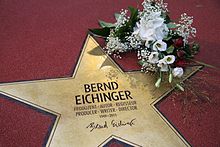
Having achieved some of its goals, among them the establishment of state funding for the film industry and renewed international recognition for German films, the New German Cinema had begun to show signs of fatigue by the 1980s, even though many of its proponents continued to enjoy individual success.
Among the commercial successes for German films of the 1980s were the Otto film series beginning in 1985 starring comedian Otto Waalkes, Wolfgang Petersen's adaptation of The NeverEnding Story (1984), and the internationally successful Das Boot (1981), which still holds the record for most Academy Award nominations for a German film (six). Other notable film-makers who came to prominence in the 1980s include producer Bernd Eichinger and directors Doris Dörrie, Uli Edel, and Loriot.
Away from the mainstream, the splatter film director Jörg Buttgereit came to prominence in the 1980s .The development of arthouse cinemas (Programmkinos) from the 1970s onwards provided a venue for the works of less mainstream film-makers.
From the mid-1980s the spread of videocassette recorders and the arrival of private TV channels such as RTL Television provided new competition for theatrical film distribution. Cinema attendance, having rallied slightly in the late 1970s after an all-time low of 115.1 million visits in 1976, dropped sharply again from the mid-1980s to end at just 101.6 million visits in 1989.[13] However, the availability of a back catalogue of films on video also allowed for a different relationship between the viewer and an individual film, while private TV channels brought new money into the film industry and provided a launch pad from which new talent could later move into film.
1990-today Modern Germany
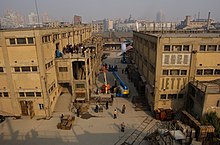
Today's biggest German production studios include Babelsberg Studio, Bavaria Film, Constantin Film and UFA. Film releases such as Run Lola Run by Tom Tykwer, Good Bye Lenin! by Wolfgang Becker, Head-On by Fatih Akin, Perfume by Tom Tykwer and The Lives of Others by Florian Henckel von Donnersmarck, have arguably managed to recapture a provocative and innovative nature. Movies like The Baader Meinhof Complex produced by Bernd Eichinger achieved some popular success.
Notable directors working in German currently include Sönke Wortmann, Caroline Link (winner of an Academy Award), Romuald Karmakar, Dani Levy, Hans-Christian Schmid, Andreas Dresen, Dennis Gansel and Uli Edel as well as comedy directors Michael Herbig and Til Schweiger.
Internationally, German filmmakers such as Roland Emmerich or Wolfgang Petersen built successful careers as directors and producers. Hans Zimmer, a film composer, has become one of the worlds most acclaimed producers of movie scores. Michael Ballhaus became a renowned cinematographer.
Germany has a long tradition of cooperation with the European-based film industry, which started as early as during the 1960s. Since 1990 the number of international projects financed and co-produced by German filmmakers has expanded.
The new millennium since 2000 has seen a general resurgence of the German film industry, with bigger-budget films and good returns at the German box office. Internationally though German productions are widely unknown and unsuccessful. The movie industry is recognized to be underfunded and rather inward looking. Since its golden age in the 1920s the German film industry has never regained the technical excellence, the star system appeal, or the popular narratives suitable for a European or global audience.[citation needed]
German Film Academy
The Deutsche Filmakademie was founded in 2003 in Berlin and aims to provide native filmmakers a forum for discussion and a way to promote the reputation of German cinema through publications, presentations, discussions and regular promotion of the subject in the schools.
Awards
Since 2005, the winners of the Deutscher Filmpreis, also known as the Lolas are elected by the members of the Deutsche Filmakademie. With a cash prize of three million euros it is the most highly endowed German cultural award.
| Year | English title | Original title | Director(s) |
|---|---|---|---|
| 2005 | Go for Zucker | Alles auf Zucker! | Dani Levy |
| 2006 | The Lives of Others | Das Leben der Anderen | Florian Henckel von Donnersmarck |
| 2007 | Four Minutes | Vier Minuten | Chris Kraus |
| 2008 | The Edge of Heaven | Auf der anderen Seite | Fatih Akın |
| 2009 | John Rabe | John Rabe | Florian Gallenberger |
| 2010 | The White Ribbon | Das weiße Band | Michael Haneke |
| 2011 | Vincent Wants to Sea | Vincent will Meer | Ralf Huettner |
| 2012 | Stopped on Track | Halt auf freier Strecke | Andreas Dresen |
| 2013 | Oh Boy! | Oh Boy | Jan-Ole Gerster |
| 2014 | Home from Home | Die andere Heimat | Edgar Reitz |
| 2015 | Victoria | Victoria | Sebastian Schipper |
Festivals
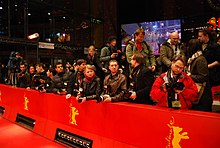
The Berlin International Film Festival, also called Berlinale, is one of the world's leading film festivals and most reputable media events.[25] It is held in Berlin, Germany.[26] Founded in West Berlin in 1951, the festival has been celebrated annually in February since 1978. With 274,000 tickets sold and 487,000 admissions it is considered the largest publicly attended film festival worldwide.[27][28] Up to 400 films are shown in several sections, representing a comprehensive array of the cinematic world. Around twenty films compete for the awards called the Golden and Silver Bears. Since 2001 the director of the festival has been Dieter Kosslick.[29][30]
The festival, the EFM and other satellite events are attended by around 20,000 professionals from over 130 countries.[31] More than 4200 journalists are responsible for the media exposure in over 110 countries.[32] At high-profile feature film premieres, movie stars and celebrities are present at the red carpet.[33]
Film Funding
The main production incentive provided by governmental authorities is the Deutscher Filmförderfonds (German Federal Film Fund) (DFFF). The DFFF is a grant given by the German Federal Commissioner for Culture and the Media. To receive the grant a producer has to fulfill different requirements including a cultural eligibility test. The fund offers 60 million euros a year to film producers and or co-producers and grants can amount to up to 20% of the approved German production costs. At least 25% the production costs must be spent in Germany, or only 20%, if the production costs are higher than 20 million euros. The DFFF has been established in 2007 and supported projects in all categories and genres.
In 2015 the Federal Ministry for Economic Affairs and Energy (Bundesministerium für Wirtschaft und Energie) launched a new film & TV funding program entitled "German Motion Picture Fund". For the first time in Germany innovative series formats and digital filmmaking will be funded at a federal level in the same manner as feature films.[34]
Film schools

Several institutions, both government run and private, provide formal education in various aspects of filmmaking.
- Deutsche Film- und Fernsehakademie Berlin (dffb) Berlin
- Film Academy Baden-Württemberg, Ludwigsburg
- International Film School Cologne, Cologne
- University of Television and Film Munich, Munich
- Filmuniversität Babelsberg, Potsdam
Personalities
-
Ken Adam, right
See also
- European Film Academy
- Cinema of the world
- History of cinema
- Kammerspielfilm
- List of films set in Berlin
- German underground horror
- World cinema
Further reading
- Bergfelder, Tim, et al. eds. The German Cinema Book (2008)
- Blaney, Martin. Symbiosis or Confrontation? (Bonn, 1992)
- Brockman, Stephen. A Critical History of German Film (2011)
- Garncarz, Joseph, and Annemone Ligensa, eds. The Cinema of Germany (Wallflower Press, distributed by Columbia University Press; 2012) 264 pages; analyses of 24 works from silent movies to such contemporary films as "Good Bye, Lenin!"
- Hake, Sabine. German National Cinema (2002; 2nd ed. 2008)
- Heiduschke, Sebastian. East German Cinema: DEFA and Film History (2013)
- Hoffman, Kay 1990 Am Ende Video – Video am Ende? Berlin
- Kapczynski, Jennifer M. and Michael D. Richardson, eds. (2012) A New History of German Cinema (Rochester Camden House, 2012) 673 pp. online review
- Kracauer, Siegfried. (2004) From Caligari to Hitler: A Psychological History of the German Film. Princeton: Univ. of Princeton Press. ISBN 0-691-11519-2
- Schneider, Irmela 1990 Film, Fernsehen & Co. Heidelberg.
- Fay, Jennifer. 2008. Theaters of Occupation: Hollywood and the Reeducation of Postwar Germany. Minneapolis: Univ. of Minnesota Press. ISBN 978-0-8166-4745-3
References
- ^ a b c "Marktdaten - Kinoergebnisse". FFA - Filmförderungsanstalt. Retrieved 25 March 2015.
- ^ "Table 8: Cinema Infrastructure - Capacity". UNESCO Institute for Statistics. Retrieved 5 November 2013.
- ^ "Table 6: Share of Top 3 distributors (Excel)". UNESCO Institute for Statistics. Retrieved 5 November 2013.
- ^ "Table 1: Feature Film Production - Genre/Method of Shooting". UNESCO Institute for Statistics. Retrieved 5 November 2013.
- ^ Pam Cook (2007). The Cinema Book. London: British Film Institute. p. 207. ISBN 978-1-84457-192-5.
- ^ Brockmann, Stephen (2010). A Critical History of German Film. Camden House. p. 13. ISBN 978-1-57113-468-4.
- ^ Brockmann, Stephen (2010). A Critical History of German Film. Camden House. p. 16. ISBN 978-1-57113-468-4.
- ^ a b Brockmann, Stephen (2010). A Critical History of German Film. Camden House. p. 18. ISBN 978-1-57113-468-4.
- ^ Brockmann, Stephen (2010). A Critical History of German Film. Camden House. p. 19. ISBN 978-1-57113-468-4.
- ^ Bordwell, David and Thompson, Kristen. (2003) "Film History An Introduction". New York: McGraw-Hill, p.200.
- ^ Brockmann, Stephen (2010). A Critical History of German Film. Camden House. p. 24. ISBN 978-1-57113-468-4.
- ^ SciFi Film History - Metropolis (1927) - Although the first science fiction film is generally agreed to be Georges Méliès' A Trip To The Moon (1902), Metropolis (1926) is the first feature length outing of the genre. (scififilmhistory.com, retrieved 15 May 2013)
- ^ a b c d e Kinobesuche in Deutschland 1925 bis 2004 Spitzenorganisation der Filmwirtschaft e. V
- ^ Schneider 1990:35, 42 & 44
- ^ a b c d Bartov, Omer "Celluloid Soldiers: Cinematic Images of the Wehrmacht" pages 130–143 from Russia War, Peace and Diplomacy edited by Ljubica & Mark Erickson, London: Weidenfeld & Nicolson, 2004 page 136.
- ^ Bartov, Omer "Celluloid Soldiers: Cinematic Images of the Wehrmacht" pages 130–143 from Russia War, Peace and Diplomacy edited by Ljubica & Mark Erickson, London: Weidenfeld & Nicolson, 2004 pages 134–135.
- ^ a b Bartov, Omer "Celluloid Soldiers: Cinematic Images of the Wehrmacht" pages 130–143 from Russia War, Peace and Diplomacy edited by Ljubica & Mark Erickson, London: Weidenfeld & Nicolson, 2004 page 137.
- ^ Bartov, Omer "Celluloid Soldiers: Cinematic Images of the Wehrmacht" pages 130–143 from Russia War, Peace and Diplomacy edited by Ljubica & Mark Erickson, London: Weidenfeld & Nicolson, 2004 page 138.
- ^ Bartov, Omer "Celluloid Soldiers: Cinematic Images of the Wehrmacht" pages 130–143 from Russia War, Peace and Diplomacy edited by Ljubica & Mark Erickson, London: Weidenfeld & Nicolson, 2004 pages 132–133.
- ^ Bartov, Omer "Celluloid Soldiers: Cinematic Images of the Wehrmacht" pages 130–143 from Russia War, Peace and Diplomacy edited by Ljubica & Mark Erickson, London: Weidenfeld & Nicolson, 2004 page 133
- ^ Bartov, Omer "Celluloid Soldiers: Cinematic Images of the Wehrmacht" pages 130–143 from Russia War, Peace and Diplomacy edited by Ljubica & Mark Erickson, London: Weidenfeld & Nicolson, 2004 page 135.
- ^ Bartov, Omer "Celluloid Soldiers: Cinematic Images of the Wehrmacht" pages 130–143 from Russia War, Peace and Diplomacy edited by Ljubica & Mark Erickson, London: Weidenfeld & Nicolson, 2004 page 139.
- ^ Information on the Filmförderungsanstalt (FFA) – German Federal Film Board
- ^ Julia, Knight (2004). New German Cinema: Images of a Generation. Wallflower Press. pp. 45–6. ISBN 978-1-903364-28-4.
- ^ 2010 Berlin Film Festival. The Hollywood Reporter Archived 2015-07-03 at the Wayback Machine
- ^ China film wins top Berlin award, BBC News
- ^ Most frequented film festivals, filmfestivals.com
- ^ Facts and Figures of the Berlinale, berlinale.com
- ^ Dieter Kosslick at IMDb, 18 February 2008
- ^ Speed Interview with Dieter Kosslick Berlinale Chief, filmfestivalstv.com, 18 February 2008
- ^ 2009 Berlinale Press release, berlinale.de, 18. February 2008
- ^ Kosslick zieht positive Berlinale-Bilanz (German), PR-inside.com
- ^ Madonna at the Berlinale, YouTube, 19 February 2008
- ^ GERMAN MOTION PICTURE FUND (PDF), 8 March 2016
External links
- German Film History
- Biographies and autographs of the early German film era
- Web portal on German film of the Goethe-Institut – Articles and news on German filmmakers, movies, festivals


